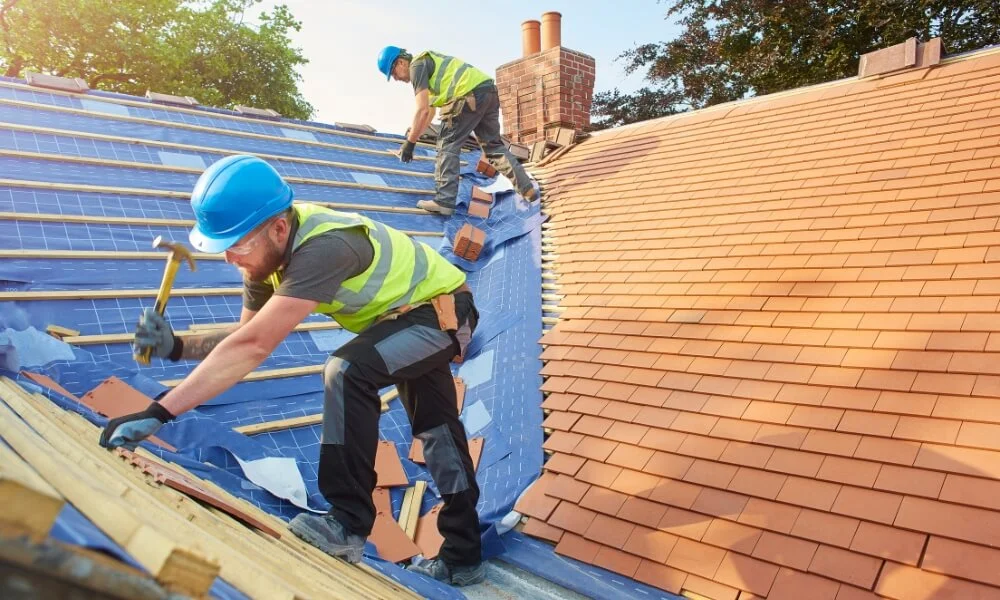Roof safety is a critical aspect of any construction or maintenance project, ensuring the well-being of workers and the longevity of buildings. Understanding the importance of roof safety is essential for anyone involved in roofing work or property management. In this article, we’ll delve into the significance of roof safety, common risks and hazards, and practical measures to promote safety on rooftops. Whether you’re a homeowner, contractor, or safety professional, there’s much to learn more about ensuring safety overhead to get learn more.
- Introduction
A. Importance of Roof Safety
Roof safety is paramount to protect workers from accidents and injuries, prevent property damage, and maintain compliance with regulations and standards.
B. Potential Risks and Hazards
Working on roofs poses various risks, including falls, slips, exposure to hazardous materials, and structural collapses, highlighting the need for rigorous safety measures.
C. Overview of Topics Covered
This article will explore roof safety regulations, common practices, accident prevention strategies, and the importance of fostering a culture of safety in roofing environments.
II. Understanding Roof Safety Regulations
A. Building Codes and Standards
Compliance Requirements
- Building codes mandate specific safety measures and structural requirements for roofs to ensure stability and resilience against various environmental factors.
Structural Integrity Guidelines
- Roof structures must adhere to engineering standards to withstand loads, such as snow, wind, and seismic forces, minimizing the risk of collapses and structural failures.
Safety Equipment Specifications
- Regulations outline requirements for safety equipment, including fall protection systems, personal protective gear, and anchorage points, to mitigate fall hazards on roofs.
B. Occupational Safety and Health Administration (OSHA) Guidelines
Fall Protection Measures
- OSHA regulations mandate fall protection systems, such as guardrails, safety nets, and personal fall arrest systems, for workers performing tasks at heights above specified thresholds.
Hazard Communication Standards
- OSHA’s Hazard Communication Standard requires employers to provide information and training on hazardous materials present on roofs, such as asbestos or chemicals used in roofing materials.
Training and Certification Requirements
- OSHA mandates training programs for workers involved in roofing activities, covering topics such as fall prevention, ladder safety, and hazard recognition, to ensure competency and compliance with safety standards.
C. Local Regulations and Permits
Zoning and Permitting Requirements
- Local jurisdictions may impose zoning restrictions and permit requirements for roofing projects to ensure compliance with building codes, environmental regulations, and neighborhood aesthetics.
Environmental Regulations
- Roofing activities may be subject to environmental regulations governing waste disposal, runoff management, and pollution prevention to minimize environmental impact and protect natural resources.
Inspection and Compliance Procedures
- Local authorities conduct inspections to verify compliance with safety regulations and permit conditions, issuing citations or penalties for violations and ensuring corrective actions are taken.
III. Common Roof Safety Practices
A. Regular Inspections and Maintenance
Identifying and Addressing Issues Early
- Regular inspections enable early detection of roof damage, leaks, or structural weaknesses, allowing prompt repairs to prevent further deterioration and potential hazards.
Cleaning Gutters and Drainage Systems
- Clearing debris from gutters and downspouts prevents water buildup and potential roof leaks, maintaining proper drainage and reducing the risk of water damage and mold growth.
Repairing Damaged Shingles and Flashing
- Prompt repair of damaged shingles, flashing, or sealants prevents water infiltration and preserves the integrity of the roofing system, minimizing the risk of leaks and structural damage.
B. Proper Equipment and Gear
Safety Harnesses and Fall Arrest Systems
- Workers should wear appropriate safety harnesses and fall arrest systems when working at heights, securing them to anchorage points to prevent falls and reduce the risk of serious injuries.
Non-Slip Footwear and Gloves
- Non-slip footwear with traction soles and sturdy gloves provide grip and protection against slips, falls, and hand injuries while working on rooftops or handling roofing materials.
Ladders and Scaffoldings
- Using stable ladders and scaffoldings with proper setup and secure footing ensures safe access to rooftops and prevents falls from heights, reducing the risk of accidents and injuries.
C. Weather Considerations
Avoiding Work During Inclement Weather
- Roofing activities should be suspended during adverse weather conditions, such as high winds, thunderstorms, or icy surfaces, to prevent accidents and ensure worker safety.
Monitoring Weather Forecasts
- Monitoring weather forecasts and planning roofing work accordingly allows for scheduling adjustments and precautionary measures to minimize exposure to weather-related hazards.
Wind Speed and Temperature Guidelines
- Adhering to wind speed and temperature guidelines for roofing work helps assess the risk of falls, material displacement, or cold-related injuries, ensuring safe working conditions for roofers.
IV. Preventing Common Accidents and Injuries
A. Falls from Heights
Importance of Guardrails and Barriers
- Installing guardrails and barriers along roof edges and openings provides physical protection against falls, reducing the risk of accidents and injuries for workers.
Proper Installation of Safety Nets
- Safety nets installed below roof work areas serve as a secondary fall protection measure, cushioning falls and preventing workers from hitting the ground or lower levels.
Safe Practices for Working Near Edges
- Implementing safe work practices, such as maintaining a safe distance from roof edges, using warning lines, and securing anchor points, reduces the likelihood of falls and enhances worker safety.
B. Slips, Trips, and Falls
Clearing Debris and Obstacles
- Removing debris, tools, and equipment from walkways and work areas eliminates tripping hazards and reduces the risk of slips, trips, and falls on rooftops.
Using Proper Footwear with Traction
- Wearing non-slip footwear with traction soles provides stability and grip on slippery or uneven surfaces, preventing slips and falls during roofing activities.
Securing Tools and Equipment
- Securing tools and equipment with tethering devices or tool belts prevents accidental drops and falls from heights, reducing the risk of injuries to workers below.
C. Exposure to Hazardous Materials
Asbestos Awareness and Removal
- Training workers on asbestos awareness and safe handling procedures prevents exposure to asbestos-containing materials during roofing projects, minimizing the risk of respiratory diseases.
Handling Chemicals and Solvents Safely
- Using appropriate personal protective equipment (PPE) and ventilation systems when handling chemicals or solvents reduces the risk of skin irritation, inhalation, or chemical burns.
Respiratory Protection Measures
- Providing respiratory protection, such as respirators or dust masks, safeguards workers against inhalation of airborne particles, dust, and fumes generated during roofing tasks.
V. Promoting a Culture of Roof Safety
A. Training and Education Programs
Safety Orientations for Workers
- Providing comprehensive safety orientations familiarizes workers with potential hazards, emergency procedures, and safety protocols before starting roofing work.
Ongoing Training and Refresher Courses
- Conducting regular training sessions and refresher courses reinforces safety awareness, updates workers on regulatory changes, and promotes continuous improvement in safety practices.
Certification Programs for Safety Professionals
- Encouraging safety professionals to pursue certification programs, such as Certified Safety Professional (CSP) or Construction Health and Safety Technician (CHST), enhances expertise and leadership in roof safety management.
B. Communication and Awareness
Safety Meetings and Toolbox Talks
- Holding regular safety meetings and toolbox talks fosters open communication, shares safety information, and encourages active participation and feedback from workers.
Reporting Near Misses and Incidents
- Encouraging workers to report near misses, incidents, or safety concerns creates a proactive safety culture, enabling prompt investigation, corrective actions, and prevention of future accidents.
Encouraging Open Dialogue about Safety Concerns
- Creating a supportive environment where workers feel comfortable discussing safety concerns, sharing ideas, and offering suggestions fosters collaboration and continuous improvement in roof safety practices.
C. Leading by Example
Management Commitment to Safety
- Demonstrating a strong commitment to safety from management sets a positive example, prioritizing worker well-being and fostering a culture of accountability and responsibility.
Providing Resources and Support
- Providing resources, such as safety equipment, training materials, and access to safety professionals, empowers workers to prioritize safety and make informed decisions on the job.
Recognizing and Rewarding Safe Behavior
- Recognizing and rewarding safe behavior, such as following safety protocols, identifying hazards, or suggesting improvements, reinforces positive safety habits and motivates continuous adherence to safety standards.
In conclusion, roof safety is essential for protecting workers, preventing accidents and injuries, and ensuring compliance with regulations and standards. By understanding roof safety regulations, implementing common safety practices, preventing common accidents and injuries, and promoting a culture of safety, stakeholders can create safer working environments and mitigate risks associated with roofing activities. Learn more about roof safety to safeguard lives and property and promote a culture of safety in the roofing industry.

